-
Paper Information
- Next Paper
- Paper Submission
-
Journal Information
- About This Journal
- Editorial Board
- Current Issue
- Archive
- Author Guidelines
- Contact Us
Electrical and Electronic Engineering
p-ISSN: 2162-9455 e-ISSN: 2162-8459
2015; 5(1A): 1-6
doi:10.5923/c.eee.201501.01
The Preliminary Study of Interrelationship of Perceived Stress to Brainwave Characteristic of Breastfeeding Women
Najidah Hambali, Hasmar Nurul Natasya Abu Hassan, Zunairah Haji Murat, Nur Idora Abdul Razak
Faculty of Electrical Engineering, Universiti Teknologi MARA, Shah Alam, Malaysia
Correspondence to: Najidah Hambali, Faculty of Electrical Engineering, Universiti Teknologi MARA, Shah Alam, Malaysia.
| Email: |  |
Copyright © 2015 Scientific & Academic Publishing. All Rights Reserved.
The purpose of this study is to analyse the stress level and brainwave characteristic of breastfeeding women, and also their interrelationship. A questionnaire of Perceived Stress Scale (PSS) has been used to indicate the stress level of sixteen breastfeeding women. In order to indicate the brain characteristic, an existing intelligent signal processing using MATLAB and specific algorithm is used to analyse data from Electroencephalogram (EEG). The outcomes showed the Brainwave Balancing Index (BBI) and brain dominance of breastfeeding women that were examined using EEG. Besides that, the correlation of PSS and BBI was presented using Statistical Package for Social Science (SPSS). The finding indicated that breastfeeding activity produces a balanced brainwave condition among the breastfeeding women even though they were in stress condition.
Keywords: Breastfeeding, Stress Level, Brainwave, EEG, Brainwave Balancing Index, Brain Dominance
Cite this paper: Najidah Hambali, Hasmar Nurul Natasya Abu Hassan, Zunairah Haji Murat, Nur Idora Abdul Razak, The Preliminary Study of Interrelationship of Perceived Stress to Brainwave Characteristic of Breastfeeding Women, Electrical and Electronic Engineering, Vol. 5 No. 1A, 2015, pp. 1-6. doi: 10.5923/c.eee.201501.01.
Article Outline
1. Introduction
- Breastfeeding activity is an important for the infant for their development and growth. Therefore, the ability of women’s to produce breast milk was also important. Based on the existing report, the production of milk is related with stress and depression affects and also cause the woman's loss their blood [1]. All of these depression, maybe comes from the factors of the women's lifestyle, ages, parity, socioeconomic status, educational level, fear of changes of the body and etc. Researchers showed that stress has been identified as the influence factor to a problem in breastfeeding; breastfeeding cessation, low breastfeeding rates and low breast milk production among the women in Kelantan, Norway, Jining City and Australia [1-4]. The stress might comes from work, disappointed their breastfeeding milk production decrease or stopped and etc. Stress level is correlated with person’s physiological features. Increased heart rate, reduced skin resistance and increased blood pressure were the measurable changes can be found under stressful condition. Some research found, to deal with variations individual stress response need to introduce person specific parameter. Hence, to accommodate the individual difference the stress evaluation method is used [5].No matter the health condition of the women, they have been described as providing more emotional work compared to men [6]. One of women stress factor has been caused by the emotions control neglection of their husbands. Besides that, stress factors like physiological, cognitive and temperament influenced women and resulting higher negative affectivity rather than positive affectivity [7]. However, negative correlations were presented in [8] that links between stress and cognitive functions. Higher stress level has been determined using [9] and linked to poor sleepers due to major life events like natural disaster, emotional dysregulation, self-control lower levels and psychiatric disorder [10]. Women might have a negative physical health function like cardiovascular disease and as well as mental health outcomes like chronic posttraumatic stress dirsorder (PTSD), depression and substance abuse because of life stress. It is also effects the memory and emotion in brain areas that activate the peripheral sympathetic and hormonal systems [11].Analysis of World Health Organization (WHO) founds that symptoms of stress and anxiety is in a linear regression was predicted at six months postpartum. Therefore, women who have higher levels of stress are more prone than others to increase their stress after breastfeeding cessation. It is also stated that during the reproductive years, depressive symptoms were affected to the women twice compared to men. Due to depression, in the first three months after delivery up to 40% of women stop breastfeeding activity [12]. Twenty eight qualitative research studies of western breastfeeding mothers have been critically reviewed. The challenge of complexity hormonal women’s bodies needs to be understood and supported as the breastfeeding rates in the West are increasing while the impact of technology and the pervasive worldwide infant formula marketing devalued the rates [13]. Mammary gland function is to secrete milk for breastfeeding women [14], [15]. Oxytocin is release from pituitary posterior when the brain is stimulated in the process suckling of the nipples and areola around the nipple. Hence, in the blood, the oxytocin travels and activated cells for contraction eject milk out of the breast. Moreover, the hormone prolactin is released during breastfeeding which gives mom a feeling of tranquility, pride, happiness, satisfaction, relief, relaxation, enjoyable and comfortable. Studies have shown that breastfeeding women have reduced levels of stress hormones in their bodies and enhanced levels of hormones that foster feelings of well-being [16]. A research on relationship of early brain development and breastfeeding has been examined among 133 children. Breastfed children and extended breastfeeding duration showed a positive relationship in several brain regions and neural growth [17]. A study showed a relationship of stress level with brainwave balancing index (BBI) [18]. Therefore, there is a need to investigate the correlation between the stress levels to the brainwave activity of the breastfeeding women. The intelligent signal processing technique was used to analyze the EEG data for the Brainwave Balancing Index (BBI) and brain dominance. This technique was combined with specific algorithm and presented via Graphic User Interface (GUI) [19], [20]. There are four levels of brainwaves, which were beta, alpha, theta, and delta. Besides that, the brain has two hemispheres which are left hemisphere that involved the behavior of speech, language and analysis [19], [21]–[23]. Another one is right hemisphere that involved in perceiving, thinking, understanding and remembering as shown in Table 1.
|
2. Methodology
- The experimental procedure was conducted and performed using facilities at Biomedical Research and Human Potential, Faculty of Electrical Engineering, Universiti Teknologi MARA, Malaysia. This research were participated by the volunteering breastfeeding women in Malaysia. The data is collected from a survey and EEG recording. Total volunteers were 16 breastfeeding women from around Peninsula Malaysia with age 25 to 38 years old.At the first stage, the volunteers were given the questionnaire on stress level. After that, the EEG of breastfeeding women has been recorded for three conditions, before, during and after breastfeeding. Then, the recorded EEG signal was analyzed using existing SIMULINK MATLAB. Consequently, BBI and brainwave hemisphere dominance of breastfeeding women were determined using EEG. From the results, the interrelationship of PSS to BBI of breastfeeding women was investigated.
2.1. Survey from the Questionnaire
- At this stage, the participants were given the questionnaire of perceived stress scale [9]. The objective of this questionnaire is to determine the level of stress of breastfeeding women. The table of stress index was computed by Table 2.
|
2.2. EEG Experimental Procedure
- All the brain spontaneous activity of breastfeeding women was recorded by EEG along the scalp in term of electrical potential. The electrical potential was produced by the interconnection of neurons. Electrocortiogram is used in EEG that put directly to the scalp surface externally while using electrogram which is depth probes. G-Mobilab was used to carry out the EEG data acquisition. Two channels were used connected along with the gold electrodes. Simultaneously, Bluetooth is used to send EEG raw data to processing device. The results was presented via Graphic User Interface (GUI) [19], [20]. Figure 2 and 3 show the procedure of EEG data acquisition.
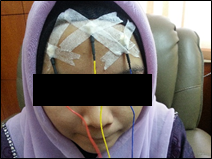 | Figure 2. Electrodes Connection (Forehead and Earlobe) |
 | Figure 3. EEG Real time and Wireless Data Acquisition |
2.3. EEG Signal Analysis
- The symmetrical properties of the brainwave signals scientifically can be evaluated by using EEG. Furthermore, brainwave dominance also can be determined whether a person has right brain dominance or left brain dominance. Hence, to filter the noise and to analyze the EEG signal, the existing SIMULINK MATLAB was used as a programming tool [19], [20]. Table 3 shows the table of the Brainwave Balancing Index while Figure 4 shows the example of BBI and brain dominance result. The brainwave characteristic was indicated by this BBI and then was compared with the questionnaire.
|
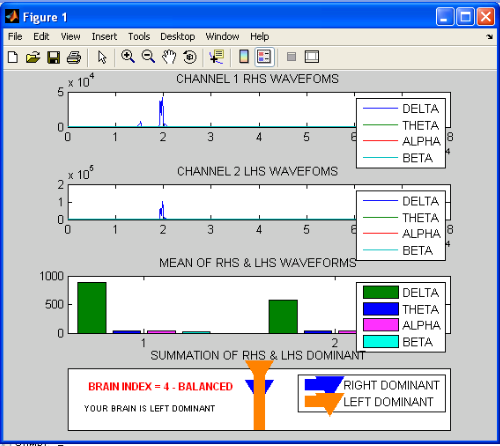 | Figure 4. Example of Result BBI [19], [20] |
3. Results and Discussion
3.1. Demographic Data of Breastfeeding Women
- EEG data were recorded from 16 participants of breastfeeding women with age 25 to 38 years old. The age of the baby was between 3 to 15 months. The data from participants were recorded by using two methods, either through direct feeding or milk expressing using a breast pump. The data were collected, 4 through direct feeding method and 12 through the milk expressing. Mostly, all the participants doesn't only breastfeed their child since their first child, but also they were supported by their families to breastfeed the children. Moreover, 4 participants were recorded for each category of supplement intake; no supplement intake, synthetic supplement intake, natural supplement intake, also a combination of synthetic and natural supplements.
3.2. Perceived Stress Scale
- Figure 5 below shows the stress index of participants, as has been determined in Table 2. As depicted, most of the participants were very high in stress, which is 10 in total, then followed by the high in stress which is 4 in total. Besides that, average and low in stress is 1 for each category. So, it can be concluded, most of the participants were under stress condition before the breastfeeding activity.
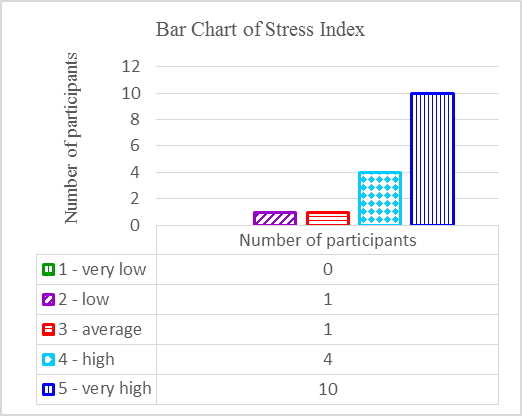 | Figure 5. Stress Index |
3.3. Result of BBI and Brain Dominance
- Figure 6 shows the recorded BBI results of participants for three conditions, before, during and after direct feeding or milk expressing. Based on the results, 11 participants were recorded with balanced BBI before the breastfeeding and 12 participants for both during and after breastfeeding. While for unbalanced BBI before, during and after breastfeeding, there were 5, 4 and 4 participants were recorded respectively.
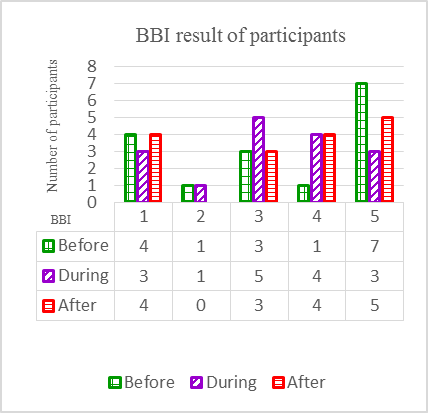 | Figure 6. BBI category on before, during and after breastfeed |
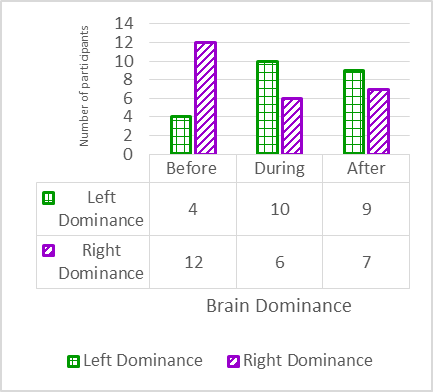 | Figure 7. Brain dominance of breastfeeding women before, during and after breastfeeding |
3.4. Statistics
- Table 4 shows a Spearman Rank Order Correlation that was computed to assess the relationship between the PSS index and BBI before breastfeeding. There was a weak negative correlation between the two variables, rs = - 0.097, n = 16, p = 0.360. Overall, there was no statistically significant correlation between these two variables since the p-value was greater than 0.05. That means, the result of PSS index did not significantly related to BBI of the women before breastfeeding.
|
|
|
4. Conclusions
- In this study, the PSS of breastfeeding women has been examined. In addition, the BBI and brain hemispheric dominance have been determined using EEG analysis. Finally, the interrelationship of PSS and BBI of breastfeeding women has been carried out. As shown in the results, balanced BBI during and after breastfeeding was higher compared to before breastfeeding. Hence, it can be concluded that the breastfeeding activity makes breastfeeding women in balance brainwave conditions, although they were in stress condition before the breastfeeding activity. Besides that, the result from this research demonstrated that there was no correlation between PSS Index and BBI before, during and after breastfeeding. So the stress level of breastfeeding women did not significantly correlated to the balancing of their brainwave. No matter what is the conditions of stress level, the breastfeeding activity still can produce balanced brainwave conditions among the breastfeeding women.Another aspect to investigate is to compare the brainwave characteristic not only between breastfeeding women and non-breastfeeding women, but also between working and non-working breastfeeding women. To include other cognitive aspects, reseacher could include more parameters in the protocol of the experiments such as taking the blood pressure, body temperature and checking the cortisol level in the saliva. The result could be further improved by increasing the number of participants.
ACKNOWLEDGEMENTS
- This project supported by a Research Acculturation Grant Scheme (RAGS) 600 – RMI/RAGS 5/3 (58/2013) funded by the Ministry of Education, Malaysia. The authors also gratefully acknowledge the use of the facilities of the Biomedical Research and Human Potential, Faculty of Electrical Engineering, Universiti Teknologi MARA, Malaysia.
 Abstract
Abstract Reference
Reference Full-Text PDF
Full-Text PDF Full-text HTML
Full-text HTML




